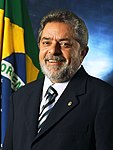Brazilian general election, 1998
|
|
|||||||||||||||||||||||||||||||||
|---|---|---|---|---|---|---|---|---|---|---|---|---|---|---|---|---|---|---|---|---|---|---|---|---|---|---|---|---|---|---|---|---|---|
|
|||||||||||||||||||||||||||||||||
|
|||||||||||||||||||||||||||||||||

Presidential election results map after voting:
Blue denotes states won by Cardoso Red denotes states won by Lula Orange denotes the state won by Gomes |
|||||||||||||||||||||||||||||||||
|
|||||||||||||||||||||||||||||||||
General elections were held in Brazil on 4 October 1998, with a second round on 25 October. In the first round Fernando Henrique Cardoso was re-elected President and the governorships of 14 states were elected, in addition to all seats in the Chamber of Deputies and Legislative Assemblies, and one third of the seats in the Federal Senate. In the second round the governorships of 12 states and the Federal District were defined. This election was marked by the use of voting machines for the first time ever. They would have been used in all municipalities two years later, in the 2000 local elections.
This was the third general election held after the promulgation of the 1988 Constitution, being also the third time Brazilians voted directly for President since the end of the military dictatorship. Shortly before these elections were held, the federal government was able to approve in the National Congress a constitutional amendment bill allowing the re-election of members of the Executive branch of government. There was much discussion about the constitutionality of the bill, and denouncements were made by the press that some parliamentarians were bribed to vote for the approval of the bill.
...
Wikipedia



